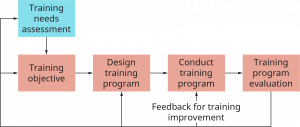9.4 Employee Training and Development
- What types of training and development do organizations offer their employees?
To ensure that both new and experienced employees have the knowledge and skills to perform their jobs successfully, organizations invest in training and development activities. Training and development involves learning situations in which the employee acquires additional knowledge or skills to increase job performance. Training objectives specify performance improvements, reductions in errors, job knowledge to be gained, and/or other positive organizational results. The process of creating and implementing training and development activities is shown in Exhibit 9.4. Training is done either on the job or off the job.
On-the-Job Training
New-employee training is essential and usually begins with orientation, which entails getting the new employee ready to perform on the job. Formal orientation (often a half-day classroom program) provides information about the company history, company values and expectations, policies, and the customers the company serves, as well as an overview of products and services. More important, however, is the specific job orientation by the new employee’s supervisor concerning work rules, equipment, and performance expectations. This second briefing tends to be more informal and may last for several days or even weeks.

Beyond employee orientation, job training takes place at the job site or workstation and is directly related to the job. This training involves specific job instruction, coaching (guidance given to new employees by experienced ones), special project assignments, or job rotation. Job rotation is the reassignment of workers to several different jobs over time. At Walmart, management trainees rotate through three or more merchandizing departments, customer service, credit, and even the human resource department during the first year or two on the job.
Two other forms of on-the-job training are apprenticeship and mentoring. An apprenticeship usually combines specific on-the-job instruction with classroom training. It may last as long as four years and can be found in the skilled trades of carpentry, plumbing, and electrical work. Mentoring involves a senior manager or other experienced employee providing job- and career-related information to a mentee. Inexpensive and providing instantaneous feedback, mentoring is becoming increasingly popular with many firms, including FedEx, Merrill Lynch, Dow Chemical, and Bank of America. Whereas mentoring is typically conducted through ongoing face-to-face interactions between mentor and mentee, technology now allows for a long-distance mentoring relationship. Dow Chemical uses e-mail and video conferencing to facilitate long-distance mentoring between persons who are working in different countries. For a mentee whose second language is English, writing e-mail messages in English helps the individual become fluent in English, which is a requirement of all Dow Chemical employees regardless of location and country of origin.8
Source contents: Principles of Management and Organizational Behavior. Please visit OpenStax for more details: https://openstax.org/subjects/view-all

